Young man in a hurry: The life of Isaac Stevens
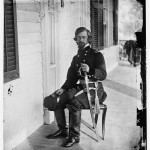 Isaac Ingalls Stevens was the first governor of the newly-formed Washington Territory in 1853. I’ve been reading more about the significance of his life since I began diving into library books about Washington state history. In a previous post I wrote about how I visited the cemetery where our first territorial lieutenant governor, Charles Mason, is buried. He served as the acting governor of Washington Territory while Isaac Stevens was away negotiating landmark treaties with the region’s Indian tribes. When I picked up a bookmark lying around at work with the picture of a seated Isaac Stevens on it and the headline, “Young man in a hurry,” I thought I must have missed some recent exposition about his life. As it turns out, I almost did.
Isaac Ingalls Stevens was the first governor of the newly-formed Washington Territory in 1853. I’ve been reading more about the significance of his life since I began diving into library books about Washington state history. In a previous post I wrote about how I visited the cemetery where our first territorial lieutenant governor, Charles Mason, is buried. He served as the acting governor of Washington Territory while Isaac Stevens was away negotiating landmark treaties with the region’s Indian tribes. When I picked up a bookmark lying around at work with the picture of a seated Isaac Stevens on it and the headline, “Young man in a hurry,” I thought I must have missed some recent exposition about his life. As it turns out, I almost did.
I took the bookmark and posted it on my wall at work with the other state memorabilia stuff I’ve collected over the years, and didn’t give it much of a second thought for weeks. Then on Friday, after I attended the bill signing ceremonies for three bills sponsored by the senators for whom I work, I was leaving the governor’s office and walking past the secretary of state’s office when who should I find looking down on me with cardboard eyes, but a life-sized poster of Governor Stevens. Above his head was a hand-written sign that read, “Last Day of Exhibit.” I hadn’t missed it after all! I took a quick peek into the secretary of state’s reception area and sure enough it was though I had walked into the Washington State History Museum…informational panels adorned the walls, genuine artifacts sat brightly lit beneath glass display cases and stacks of informational pamphlets lay invitingly on the counter.
I approached the girls at the counter, who were locked in a three-way lunch conversation, to ask how late they would remain open for the day. After they told me 5:00 p.m., I told them I would return around 4:30 to peruse the exhibit. However Fridays being what they are, a load of last-minute work forced me to phone the secretary of state’s office to find out what is to become of the exhibit once they take it down. The woman on the phone told me that sometimes the exhibits go traveling around the state and that they hadn’t scheduled this particular exhibit for a destination just yet. I assume it was at that point she looked at her phone and saw my extension was coming from within the capitol campus, because asked if I was working Monday and suggested I come in early to see it before they start taking it down. Problem, meet solution.
So I made my way into the Legislative building shortly before 8 Monday morning, the echoing sound of my dress shoe heels clacking across the marble floors being the only sign anyone was awake yet. Most of the offices were closed and locked, but the secretary of state’s office was wide open with nary a soul in the room. I had brought my camera to take pictures of the exhibit, and began making my way around the reception area, taking the time to read every word and study every photograph. Perhaps the piece with the most impact in the exhibit – at least to me – was a small, wooden chair in which Governor Stevens actually sat when he took his place behind his desk. It was roped off, but with nobody in the room I was very tempted to take a seat. Decorum got the better of me however, and I restrained myself to just a slight touch of the chair’s glossy arm. Having a physical connection to a part of history has always helped me to feel more connected to it.
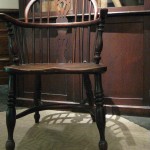 The chair sat in front of a book case that was reportedly built by Stevens himself. Part of the story goes that – after learning he had been named the first territorial governor by President Franklin Pierce – Stevens purchased over 2,000 books from around his home on the east coast and had them shipped to Washington to become the makings of the first state library. Once he arrived on site several months later, he used the wooden crates from those book shipments to construct the bookcase…which frankly sounds like something I would have done, being the resourceful-or-cheap person that I am (depending on if you’re talking to me or my wife).
The chair sat in front of a book case that was reportedly built by Stevens himself. Part of the story goes that – after learning he had been named the first territorial governor by President Franklin Pierce – Stevens purchased over 2,000 books from around his home on the east coast and had them shipped to Washington to become the makings of the first state library. Once he arrived on site several months later, he used the wooden crates from those book shipments to construct the bookcase…which frankly sounds like something I would have done, being the resourceful-or-cheap person that I am (depending on if you’re talking to me or my wife).
Further circling the room, I learned a wealth of new details about the man. For example, his mother was killed in a car accident…okay, it was a stagecoach accident, but his father was the one at the reins. After joining the Army and graduating from West Point, he served valiantly in a number of 19th century conflicts including the Mexican-American War. After he was named territorial governor – an office which came with the additional title of Superintendent of Indian Affairs – he also added Continental Surveyor to his growing resume, taking it upon himself to survey a route for a future intercontinental railroad as he traveled across the mid-western prairie on his way to Washington. Later, he would write several books about his military service and countrywide survey experience, adding author to his impressive repertoire.
 Stevens is perhaps best known for his unwavering devotion to the expansion of United States territory. Author Kent Richards is quoted as describing Stevens as “a man either loved or hated, but seldom ignored.” Wikipedia describes Stevens a controversial governor in his time, who has become more controversial in retrospect. Whether you believe it was by deception and trickery or a result of the concept of manifest destiny, Stevens negotiated with the Native American tribes of Washington Territory (which then included parts of present-day Idaho and Montana) in a U.S. government-sanctioned effort to encourage them to sign treaties that handed over most of their lands. These included the Treaty of Medicine Creek, Treaty of Hellgate, Treaty of Neah Bay, Treaty of Point Elliott, Point No Point Treaty, and Quinault Treaty. When Stevens was met with resistance, he used the troops at his disposal to enforce the treaties. His actions during the years 1855 and 1856 are thought to have contributed to the Indian Wars of Washington Territory against the Yakama tribe, led by Chief Kamiakin, and the Nisqually chieftain Leschi, who was later executed for the crime of murdering two of Stevens’ soldiers. That, too, was quite controversial and many believe Leschi was innocent of the crime for which he gave his life.
Stevens is perhaps best known for his unwavering devotion to the expansion of United States territory. Author Kent Richards is quoted as describing Stevens as “a man either loved or hated, but seldom ignored.” Wikipedia describes Stevens a controversial governor in his time, who has become more controversial in retrospect. Whether you believe it was by deception and trickery or a result of the concept of manifest destiny, Stevens negotiated with the Native American tribes of Washington Territory (which then included parts of present-day Idaho and Montana) in a U.S. government-sanctioned effort to encourage them to sign treaties that handed over most of their lands. These included the Treaty of Medicine Creek, Treaty of Hellgate, Treaty of Neah Bay, Treaty of Point Elliott, Point No Point Treaty, and Quinault Treaty. When Stevens was met with resistance, he used the troops at his disposal to enforce the treaties. His actions during the years 1855 and 1856 are thought to have contributed to the Indian Wars of Washington Territory against the Yakama tribe, led by Chief Kamiakin, and the Nisqually chieftain Leschi, who was later executed for the crime of murdering two of Stevens’ soldiers. That, too, was quite controversial and many believe Leschi was innocent of the crime for which he gave his life.
After Stevens left office, he became the congressional delegate for Washington Territory for two years before his military calling would once again take hold of his destiny. When the American Civil War began in 1861, Stevens was commissioned as a colonel to lead the 79th New York Volunteers, known as the “Cameron Highlanders.” He became a brigadier general on September 28, 1861, and fought in numerous Civil War battles. Stevens was killed in action by a bullet to the head at the Battle of Chantilly on September 1, 1862. He witnessed the death of the man who was carrying the flag of his Highlanders unit, and ran to pick it up, shouting “Highlanders, my Highlanders, follow your general!” Leading the charge – coincidentally past his seriously wounded son, Hazard Stevens (seen standing in the picture above as the only man without facial hair) – carrying the banner of Saint Andrew’s Cross, Stevens was struck in the temple by a bullet and died instantly.
He was buried in Newport, Rhode Island at Island Cemetery. In March 1863, he was posthumously promoted to major general, backdated to July 18, 1862. Hazard Stevens, Isaac’s son, was also injured in the Battle of Chantilly. He – like his father – eventually became a general in the U.S. Army and an author, and participated in the first documented ascent of Mount Rainier (about which I’ll write more in the coming years as I lead up my my own summit of Washington’s highest peak). Hazard Stevens established the Cloverfields Dairy Farm in Olympia, Washington, in 1916. Now on the National Historic Register, the former farm is the site of the present Olympia High School. Of interesting note, I discovered what a St. Andrew’s Cross is and realized that the same symbol is set into the holster of Hazard Stevens’ pistol, as you can see from the pictures below.
My thanks to Hilary Eaton at the Washington Secretary of State’s Office for letting me get a last-minute look into the life of Washington State’s founding father.
- The formal portrait of Governor Stevens still hangs in the governor’s office.
- A nice description of the Stevens chair in the foreground.
- The story goes that Stevens’ wife, upon viewing Olympia for the first time, was so depressed she didn’t leave the house for two months.
- During his travels, Stevens had an artist with him to document the scenes.
- No, not the basketball team. ACTUAL generals who served here.
- If Hazard was also in the Highlanders it would explain the cross.
- Hazard Stevens’ pistol with the monogrammed cross inlaid in the grip.
- I have to wonder how often he sat here and thought about the fate of our territory.
- Bookcase made out of the shipping crates in which Stevens sent books to Washington.
By the way, since I hate to end things on such a sour note, if there were ever a movie made about the life of Isaac Stevens he would have to be played by his doppelgänger, Brad Pitt.
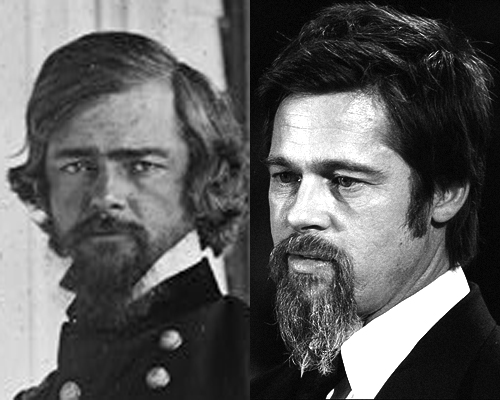
The Life of Isaac Stevens, starring Brad Pitt.


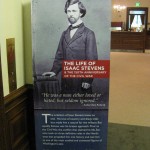
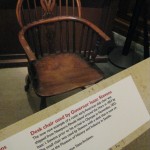
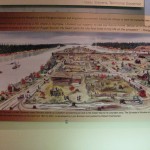
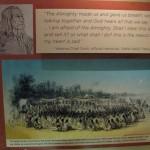
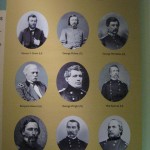
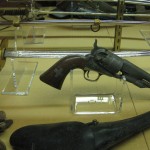
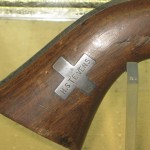
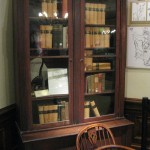
Stevens never negotiated with any of the WA state tribes. He used martial law and internment camps to force the natives to sign his treaties. He even had Chief Leschi murdered because he refused to sign. Suggest you watch: https://www.youtube.com/watch?v=hwr2CBo7yds
I think the cross on Steven’s pistol was more likely a depiction of St Georges cross. Great article 🙂
Stevens was in every sense, a real man. I found a book belonging to him and owned for several years. He had used a copy of some bound 1856 federal reports printed by congress as a scrap book. He then gave the book to a prominent formerly eastern minister living in Scio, Oregon. The scraps in the book were from many eastern & southern newspapers. I wish I had kept it.
Stevens was a true patroit. May he never be forgotton.
Pat mcfadden
Bend, Oregon
Pingback: Go Fish | SHRA
Wow Brad Pitt looks like General Isaac Stevens perfect!
Thanks for this great review of our Washington State Heritage Center exhibit in the Secretary of State’s office. We are very pleased that you enjoyed learning more about Isaac Stevens. The exhibit, now taken down, will be traveling to other museums. Watch the Heritage Center website, http://www.heritagecenter.wa.gov, for updates on the location of the Stevens exhibit. Our new exhibit,. “We’re Still Here” The Survival of Washington Indians opens on April 24. Be sure to stop by to see that exhibit as well.
Wow! What a GREAT. Write up!